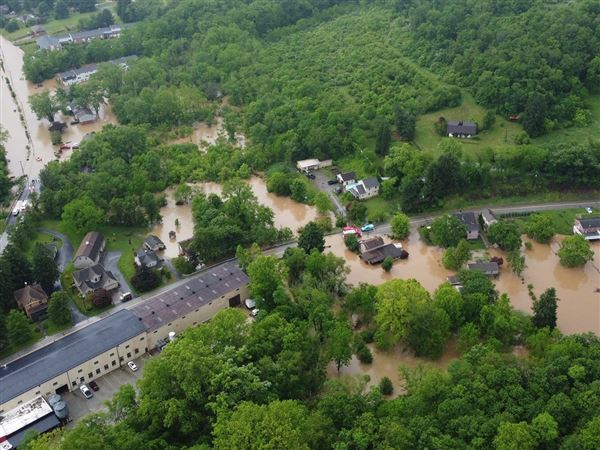The Thomsons bought a plot in the quiet Braes Heights neighborhood seven years ago with the vague yet ambitious idea to build an elegant house that would be both hurricane-resistant and eco-friendly.
It seemed like a simple enough task with green homebuilding gaining in popularity. But owner Ker Thomson faced a steep learning curve and soon found himself swimming in complex concepts, from radiant barriers to heat transfer. To further complicate matters, during his first six months researching green building techniques, he found conflicting opinions about the best way to build.
He eventually figured it out, with help. The house at 3703 Drummond is now possibly the first in Houston to earn a combined LEED Platinum certification, “Fortified Rated” designation from the Institute for Building and Home Safety and Zero Energy Ready Home certification from the Department of Energy.
‘‘It represents a fundamentally different way to build a home and was designed for the U.S. Gulf Coast,” Thomson said. “It still has all the amenities and appearances of an elegant custom home, but we have changed the game behind the Sheetrock. The short- and long-term benefits from this type of construction become obvious, especially when viewed as a complete package.”
Green building has been on the rise in commercial and residential construction nationally the last several years and become a focus in Houston, where Mayor Annise Parker recently announced goals to reduce greenhouse gases in commercial projects.
Home uses ‘40% less’ power
The Drummond house, which recently got its certifications, was featured in a green building tour last weekend, and the U.S. Green Building Council held an open house there earlier this month.
Most new Class A commercial projects in the city aim to be LEED-certified. Growing numbers of homeowners are investing in energy-efficient technologies. Even affordable housing agencies are building houses with solar panels and eco-friendly technologies.
In his early struggles with green technology, Thomson enlisted a band of efficiency wizards at the Texas A&M Energy Systems Laboratory in Bryan. A yearlong collaboration followed.
‘‘We guided him through some concepts, and we had a lot of discussions. It was a fairly dynamic type relationship,” said A&M doctoral student James Sweeney, who works at the lab.
The lab helped Thomson make decisions on everything from where windows should go to how to ventilate the attic, to which contractors and materials to use.
The home, nestled among the ranch-style houses in a leafy Bellaire-area neighborhood, has three stories, six bedrooms, arched doorways and a sweeping staircase. There is even a wine cellar, state-of-the-art kitchen and outdoor grilling area.
What makes it different and keeps energy costs down: a foam-sealed attic, walls insulated with concrete foam, triple-paned laminated windows, LED lights and a roof of metal shingles. There are also solar panels, solar-powered hot water and a system that captures rainwater and filters it.
‘‘This house is very tight. Super tight,” Sweeney said. “That type of house uses 40 percent less energy than the house across the street.”
Building on a thesis
Sweeney, who specializes in building science and ventilation, spent so much time at the Drummond house that he discovered the perfect opportunity for his doctoral work. Research on how the house was built and what it means for the future of green building became the core for his thesis, which he presents this spring.
He studied electric bills and installed a metering system on the heat pump and air conditioning systems to verify how much renewable energy was created. He climbed on the roof and measured the heat it reflected and how it helped reduce energy use in the house.
In the thesis, he will compare this house to traditionally built homes. How much less energy does it use? What works and doesn’t? What are the tradeoffs associated with green building? He already knows that thick walls help keep air and heat from entering the house, which allows the air conditioning to work less.
His end goal is to see more energy-efficient building in Houston.
‘‘I know things have changed with people’s awareness about all of this,” he said. “It’s an opportunity to showcase building practices.”
Thomson, an anesthesiologist, his wife, Rachel, a former Houston Ballet ballerina, and his teenage children Audrey and Bradley now have lived in the house for the last couple of years. Thomson later started his own energy-efficient building company, Durable Energy Builders, with Houston builder Jim Kuchenbrod and local plastic surgeon Carl Perry.
Thomson said the monthly energy bills for his 6,400-square-foot home run between $150 and $300, and most of the energy used is for the washer and dryer. He said the bill for similarly sized homes would run more than $1,000.
The building’s final price tag was between 15 and 20 percent more than it would cost to build a normal house, Thomson said. He said the lower energy bills and lower insurance rates make the extra investment worth it. He also said it’s a healthier home, which has helped his son’s asthma, making the savings even greater.
‘‘This house is going to be here in 50 years, and for all intents and purposes it will look the same,” he said. “No one will say, ‘Let’s tear it down.’”
First Published: October 22, 2014, 4:00 a.m.















